10 Fail-Safe Email Lead Generation Tactics that Engage

10 Fail-Safe Email Lead Generation Tactics that Engage
Email lead generation is simply targeted marketing through email outreach. Rather than calling potential clients or undertaking other digital marketing practices, those conducting email lead generation send strategically crafted emails to audiences that may become paying customers.
Leads may be the single most important thing to keeping companies going. Leads create sales and conversions, which later become revenue. Without prospective customers, the sales process itself doesn’t work.
There are tons of ways companies can connect with leads, especially given the increasing number of tools and technologies available. In a day, a consumer may communicate with companies over the phone, on social media, or over email.
This article will focus solely on how to approach email lead generation. We explore why it’s essential to have email marketing practices, even in this technological age. Then, we offer our top 10 email lead generation tactics that are known to engage audiences.
Looking to partner with a lead generation firm to take work off your plate? Get in touch with a top-ranking company on The Manifest.
What is Email Lead Generation?
Email lead generation is the process of reaching out to potential customers and clients via email marketing.
Starting an email lead generation process at your company is both affordable and effective. However, it does require companies to obtain emails of potential leads or have them opt in to receiving emails. This is one of the main challenges of email marketing.
However, once funnels and systems are established, email marketing becomes, arguably, the most viable and sustainable marketing option available to businesses.
There are two main types of lead generation: outbound and inbound.
- Inbound lead generation: Involves a potential customer discovering brand content organically, which leads them toward conversion
- Outbound lead generation: direct outreach that requires research and targeting of potential customers, encouraging conversions from specific individuals
Email marketing can be part of either inbound or outbound lead generation strategies depending on the type of email sequence utilized in contact.
Why is Email Good for Lead Generation?
Today, many companies may be tempted to overlook the power of email marketing. After all, how many marketing emails do you open and engage with on a regular basis.
The truth is, email lead generation still gets businesses the most bang for their buck. The estimated ROI for email marketing is 4400%, exceeding that of any other form of lead gen.
Email is ideal for generating leads because of its accessibility for both the marketer and customer. Almost everyone has an email address, unlike certain social media accounts. Your potential reach using email marketing is much higher than most other forms of outreach.
Secondly, email marketing can be done en masse, unlike cold calling. A marketer can send an email to a list of 1,000 customers in an instant. It would take ages to cover that ground over the phone. This makes email marketing more cost-effective for businesses.
Plus, some email addresses are designated for work, and others are for personal use. Discerning the purpose of an email address early allows marketers to understand their audience before any outreach is conducted at all.
Email lead generation is proven to work and can easily be integrated into onboarding workflows, making the purchasing process seamless for buyers. In the end, you’ll earn happy customers that are impressed with your customer service through email lead generation.
Of course, there are plenty of ways email marketing can go wrong. Stick to our top 10 email best practices to make sure your program is successful.
Top 10 Email Lead Generation Tactics
Email is ideal for lead gen, but it isn’t fool-proof. Companies looking to improve their processes should start with these 10 tactics to boost email engagement.
- Set the tone with your subject line
- Invite conversions with clear CTAs
- Determine a lead generation magnet
- Personalize your signature
- Establish a visual hierarchy
- Automate your follow-up emails strategically
- Refine email copy with A/B testing
- Invest time in lead scoring
- Avoid spammy practices
- Track results-oriented metrics
Companies looking to step up their email lead generation performance will benefit from trying out some of these strategic approaches.
1. Set the Tone with a Subject Line
A subject line is the first thing leads will see when they come across your email in their inbox. It is a major factor in determining whether a consumer will click on the email or leave it unread.
Subject lines set the tone of the email. In other words, a subject line informs readers what they should expect upon opening the message. Marketers should always keep this top of mind and ensure that they avoid sending emails with misleading or sensational subject lines.
While it’s key to not make empty promises in the subject line, we still want the message to be enticing enough for people to click to read the rest of the email.
Company subject lines should be short, snappy, honest, and appealing to the audience segment you're reaching out to. In order to illustrate this, we’ll examine Search Engine Journal’s email marketing to its subscribed email list.

SEJ keeps subject lines short, so readers get the jist of the email and receive some preview text in their inbox, providing even more context. This subject line reads “SEJ Today: 10 Different Ways To Get Organic Page 1 Google Rankings.”
This email was sent to those who subscribe to the SEJ Today newsletter, so including the name of the newsletter is essential in getting subscribers to open. From there, the goal of the newsletter is to get clicks to new content. SEJ achieves this by teasing a top headline that reveals what readers can expect from the outlet’s most recent content.
This subject line knows its audience, is to the point, and doesn’t overpromise anything to readers.
2. Invite Conversions with Clear CTAs
Once a reader opens your email, your goal in lead generation is to steer them toward taking a specific action.
This could be reading an article, buying a product or service, scheduling a consultation meeting, and tons more. A good email marketer knows that the desired action must be super clear to the audience in order for the email to be effective. That’s where CTAs come into play.
A call to action (CTA) is a phrase or statement that asks an audience to do something. They’re easy to spot in marketing emails because they’re often in large font, anchor a link to a business site, and contain an action word.
Marketers style CTAs this way to draw an audience’s eye to the desired action and quickly entice a click that will guide the lead further down the sales funnel.
We see how SEJ handles CTAs after clicking to open the above email. It doesn’t take long to spot the CTA among the rest of the email copy — it’s nested in a bold font, nested in a green button.

The branded green button adds a pop of color that draws the reader’s attention and the enlarged text contributes to the visual hierarchy as well. The CTA text is a simple two words: “Keep Reading.”
In this case, SEJ’s goal is to get newsletter subscribers onto their website to browse the latest search engine news. Telling an audience to “Keep Reading” quickly communicates the desired action without coming across as spammy.
CTAs should be honest and obvious. Readers should know the goal of your email without even having to think about it. Their clear understanding of your email will make them more likely to click through to your website.
3. Determine a Lead Generation Magnet
A lead generation magnet is something that attracts leads to your site and encourages them to subscribe to a newsletter or join an email list.
Lead generation magnets have an inherent value that consumers are willing to give their contact information to obtain. When selecting a lead magnet of your own, think about the resources and content available to you. You may already have something that would work!
One of the more common examples of a lead gen magnet is gated content, meaning that those interested in accessing it must provide some personal information. Gated content can take the form of just about anything:
- Slide deck
- Poster
- Whitepaper
- E-book
- Case studies
- Published research
Typically, companies collect a name, email address, and possibly company size or position title.
SEJ offers several pieces of gated content that contain in-depth research, statistics, and expert opinions on the state of SEO and marketing. Here is an email encouraging current subscribers to download gated content.
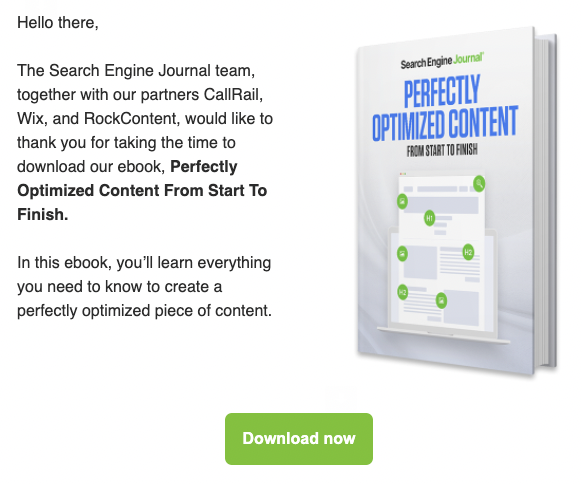
Creating a piece of gated content takes time, effort, and resources. However, lead generation magnets like this can bring in a steady flow of leads.
4. Personalize Your Email Signature
A personalized email signature goes a long way to humanizing your email communications.
People receive hundreds of emails every day. It’s easy to forget that there are humans at the other end of all of these messages, especially given the amount of automation in email marketing.
A personalized email signature is great for showing your audience exactly who they’re talking to (and who they can address in a response with questions or thoughts).
An email signature is also a great place for subtly spreading brand awareness by using a uniform design along with colleagues. These signatures can contain any or all of the following:
- A small headshot
- Your name
- Your job title
- Your preferred pronouns
- Links to company social accounts
- Link to your company website

These signature components make it clear who readers are talking to when receiving marketing emails. Personalized signatures are particularly impactful when working with cold outreach, serving as an introduction to you and your company.
Additional reading, ‘6 Email Marketing Tips: Email Signature Branding.’
5. Establish a Visual Hierarchy
A visual hierarchy refers to the way in which your email is laid out and formatted.
All the visual components should make sense in relation to each other to guide a reader’s eyes through email copy as you intend.
Here are a few elements that impact the visual hierarchy of an email:
- Text size and weight: Large, bold text will draw the eyes of your audience first.
- Spacing: Is there a lot of white space on your email? The space between elements dictates how your audience will navigate the page.
- Color: Color will attract attention while also serving as a branding opportunity for your email.
- Contrast: Light and colors of opposite extremes looks dramatic when put next to each other. Contrast also draws the reader’s attention
- Placement: In the United States, people read from left to right. Eyes will naturally start at the top left of the page when people open an email because of this reading norm.
Check out how each of these elements is at play in the aforementioned SEJ marketing email.
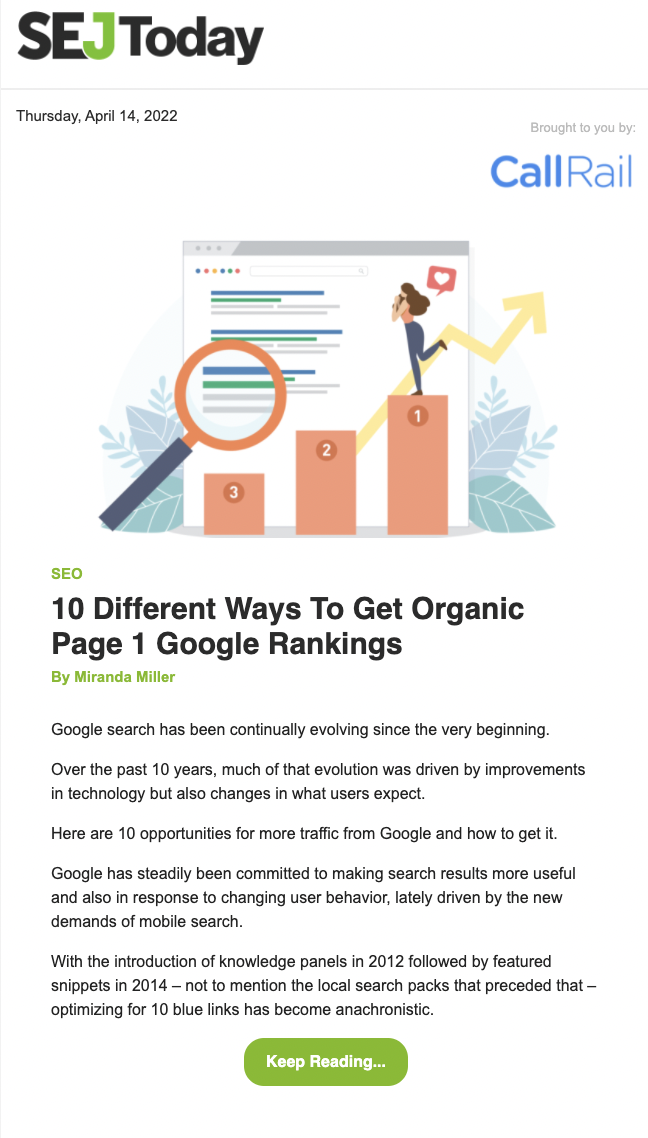
The bold text in the company name is replicated for the headline of the promoted piece of content. The repetition establishes a sense of brand unity while the large text tells readers where they should be looking first.
Of course, the CTA is also highlighted as an important feature with its bold text and colorful button.
A visual hierarchy will make your marketing emails easy to understand and digest.
6. Automate Follow-Up Emails with a CRM
Email lead generation is simplified through the use of customer relationship management (CRM) systems.
CRMs like HubSpot allow marketers to create email lists, draft and schedule email sequences, design marketing emails, and more directly on the platform.
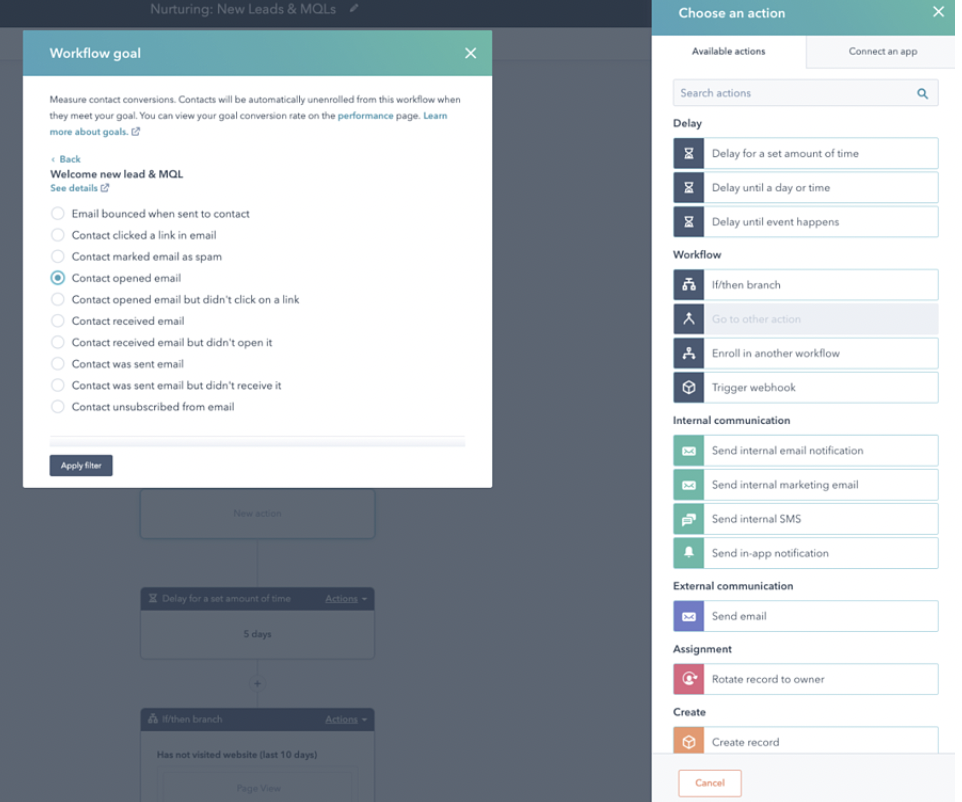
Source: HubSpot
This allows for strategic approaches to email lead generation. Automated emails also enable leads to have several touchpoints with your brand without requiring active management on your part.
For instance, if a lead decides to click through to your website and buy a product, a company may program their CRM to send an automatic “thank you” email to express appreciation for their purchase.
Automated emails like this establish a strong relationship with customers early in their experience with brands.
7. Refine Email Copy with A/B Testing
Email copy will likely take up the bulk of your marketing emails, so it’s important that customers resonate with your messaging.
How do you ensure that customers like your email copy? Test it! The most effective way to test email copy is through A/B or split testing.
A/B testing requires companies to write two versions of the same email. The first version acts as the control while the second version of email copy serves as a challenger.
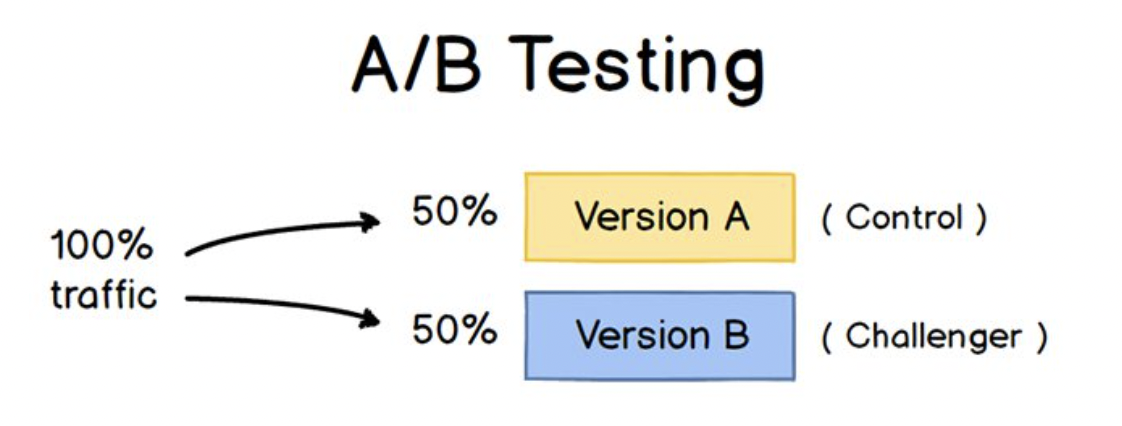
Source: CXL
In this test, half of your emails will be sent the first version while the other half of your audience will receive the second.
Using a CRM, you can track important metrics such as open rate, click-through rate, and more to determine which email is stronger. Once you’ve determined the better email copy, you can scrap the loser and fully integrate the better email copy into your campaign.
8. Invest Time in Lead Scoring
We’ve spent time discussing how to make your emails as appealing as possible to leads, but not all leads are going to be ideal for your services.
Catering to leads that aren’t a strong match for your services will only result in wasted time and energy. Lead scoring will help you keep your finger on the pulse of your leads’ intent when interacting with your emails.
Lead scoring involves two major factors: qualification and interest level. Some leads may seem very interested in your services but aren’t a good fit for you. This implies that they don’t fully understand your business and may not be as good as other leads.
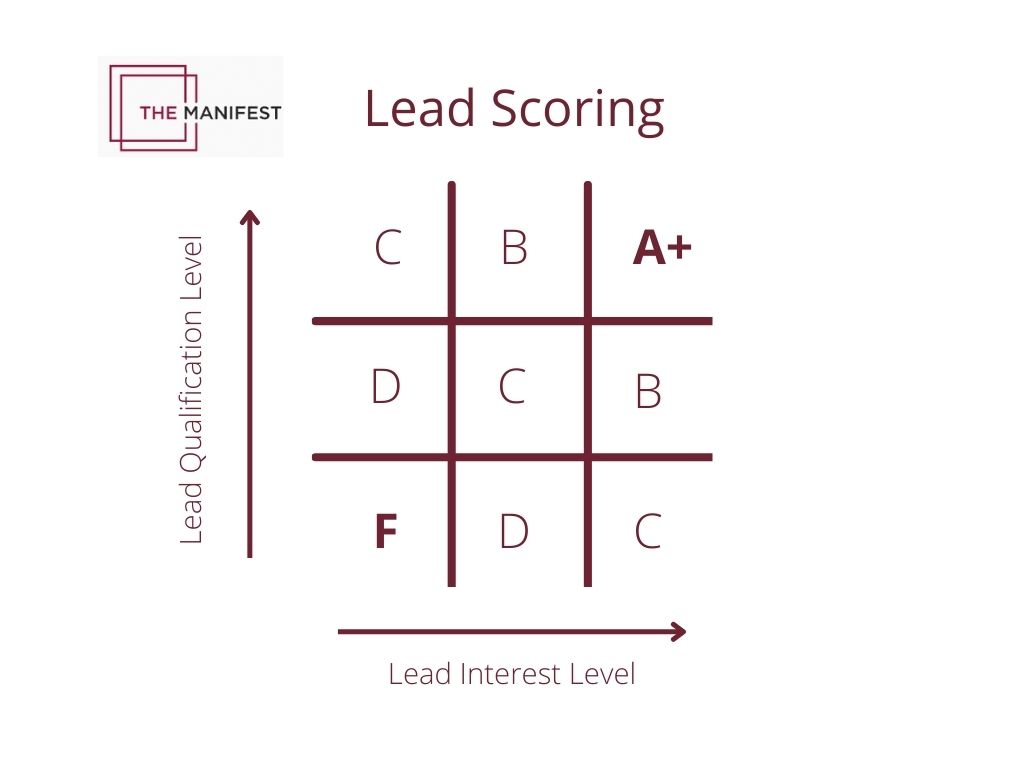
Alternatively, lead qualification is a measure of how well a certain lead fits into your idea of an ideal client. Qualification can be composed of countless features, such as client age, income, religious ideologies, location, and more. Your company’s goal should be to interest the most qualified leads through marketing content.
However, not all qualified leads will be interested in your services. A low interest level will also decrease the likelihood of an eventual conversion or purchase.
Lead scoring helps you sort your leads from most likely to convert to least likely, which can guide your marketing team’s priorities. If your team knows which leads are most important to the company, they can put special focus on those and create automated email messaging accordingly.
9. Avoid Spammy Messaging Practices
For many reasons it’s crucial to practice email lead generation professionally, including avoiding spammy practices.
Here are a few red flags that indicate email spam:
- Sending too many emails
- Sending emails that lack relevancy
- Using sensational language
- Not including an unsubscribe button
- Emailing people who haven’t opted in to an email list
- Omitting personalization within email copy
These factors and others can drive consumers away from your brand and product, decreasing their interest in working with you.
Further, spammy email practices will decrease your email deliverability, which affects where you sent emails are placed in inboxes.
The last thing you want is your emails getting sent straight into people’s spam folders. To avoid this, stay away from email practices that resemble spam and audit your process if needed.
10. Track Results-Oriented Metrics
Metric tracking can be a difficult conversation because there are so many possible metrics to track. Especially in email marketing, it can be easy to get caught up in vanity metrics, which are non-consequential to your success as a business.
Think back to your overall goals. What did you want out of this email marketing campaign? If it was brand awareness, open rate or click-through rate may be good metrics to track because they indicate how visible your branding elements were to your audience.
However, a company looking for conversions may not be satisfied with looking at the open rate or click-through exclusively because they don’t provide insight into purchases or sales. In this case, companies may want to track their return on investment (ROI) of an email marketing campaign or even overall conversion rate.
Whether your ideal result is, there’s a metric out there to match. Make sure that you’re spending time tracking metrics that directly relate to your main campaign goals.
Email Lead Generation Engages New Clients
Email marketing is a great way to cast a wide net and interact with qualified leads. Marketers have a high level of control when it comes to crafting the perfect email copy and refining email lists throughout the process, making email lead generation a must for businesses looking for strategic marketing approaches.
Lead gen can be tough. Connect with a professional lead generation team to simplify the lead gen process and grow your business.
Additional Reading
